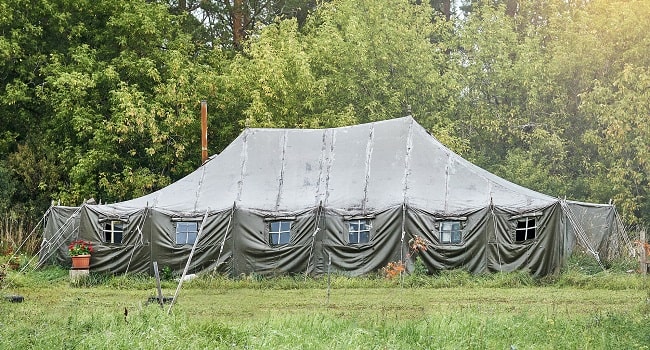Military shelter systems are essential for providing comfortable and secure housing for military personnel. They are portable and easy to set up, making them convenient for use in emergencies and remote areas. Military shelter systems can withstand harsh environmental conditions, provide security, and be customized to meet various needs.
Military shelter systems have many uses in military applications, such as disaster relief operations, training, and housing. With advancements in engineering and technology, these structures have become more efficient and versatile. In this article, we discuss the benefits and uses of military shelter systems, emphasizing their importance in providing secure and safe housing for military personnel.
Benefits Of Military Shelter Systems
These structures offer several benefits in military applications:
1. Durability
A military shelter system is composed of high-quality materials that resist harsh environmental conditions. It can withstand high temperatures, heavy loads, and high winds, making it ideal for military applications. Their durability makes them useful in military applications like conflict zones, training exercises, and expeditionary missions.
2. Security
These structures provide the ultimate security for military personnel. Engineers can equip military shelter systems with blast protection systems to guard personnel against the effects of explosive devices. Military shelter systems can withstand small-arm fire and are immune to ballistic penetration. The high security of these structures makes them vital in conflict zones with an increased risk of attack.
3. Portability
Military shelter systems are easy to transport and quick to set up. Their portability makes them suitable for use in remote areas and emergencies. In disaster relief operations, the military can deploy shelter systems to provide temporary housing for injured and displaced people. They can even serve as command centers for rescue operations or makeshift hospitals.
4. Customizability
Military shelter systems are customizable depending on their intended use, such as the need for medical facilities. Military engineers can equip military shelter systems with multiple features like lighting, heating, and air conditioning to create a comfortable living space for military personnel.
5. Sustainability
Military shelter system designs are environmentally sustainable. These structures have filtration systems and solar panels that reduce their environmental impact. They are suitable for military operations prioritizing sustainability and reducing their environmental footprint.
6. Cost-Effectiveness
Military shelter systems are cost-friendly compared to traditional military structures. They can be easily transported and set up, eliminating the need for expensive and time-consuming construction.
7. Rapid Deployment
Emergencies like humanitarian crises and natural disasters require rapid deployment of military personnel. Military shelter systems offer a quick solution to housing needs. Their enhanced mobility and easy setup make them easy to install and use, allowing military personnel to respond quickly to emergencies.
8. Energy Efficiency
Military shelter systems are energy-efficient. Solar panels, LED lighting, and insulation reduce operating costs and energy consumption.

Uses Of Military Shelter Systems
Military shelter systems have several uses in military applications:
1. Disaster Relief Operations
Military shelter systems can be easily and quickly deployed in disaster-stricken zones. They can serve as command centers, provide temporary housing, and function as field hospitals.
2. Training
Military shelter systems are functional for training exercises. These structures provide a realistic environment for military personnel to train in. Military shelter systems can serve as observation or command posts during training or be used to simulate combat situations, providing a safe location for military personnel to train in.
3. Housing
The most common use of military shelter systems is housing personnel during deployment. They provide a comfortable living environment, allowing military personnel to carry out their duties comfortably and efficiently. Access to secure and safe housing can enhance personnel’s morale and increase the effectiveness of operations.
4. Expeditionary Missions
During expeditionary missions, military shelter systems provide secure and comfortable housing for military personnel. They are ideal for use in remote areas because they can be quickly moved and set up. They can be used to create storage facilities, field hospitals, or communication facilities, ensuring that expeditionary missions run smoothly.
In addition to their mobility and versatility, military shelter systems also offer excellent protection from the elements and potential threats. They are often designed to withstand harsh weather conditions, such as high winds, heavy rain, and extreme temperatures.
The Importance Of Military Shelter Systems
Military shelter systems are durable, versatile structures designed to provide secure and comfortable housing for military personnel. They offer numerous benefits, including durability, security, portability, and cost-effectiveness. Additionally, engineers can equip these structures with heating, lighting, and air conditioning features.
Continual advancements in technology and engineering are making military shelter systems increasingly efficient and versatile. Governments should prioritize investing in the development and enhancement of these systems to ensure the safety and security of their troops. Utilizing military shelter systems can boost troop morale, guarantee the safety of military personnel, and ensure the smooth functioning of military operations.




























